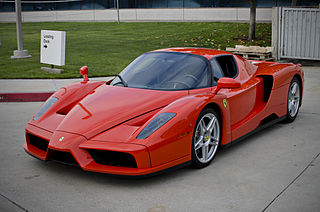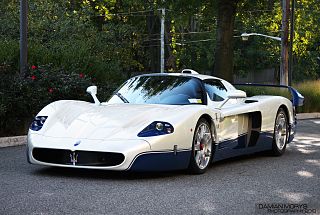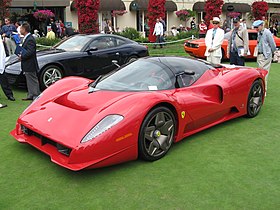
The Ferrari Testarossa is a 12-cylinder mid-engine sports car manufactured by Ferrari, which went into production in 1984 as the successor to the Ferrari Berlinetta Boxer. The Pininfarina-designed car was originally produced from 1984 until 1991, with two model revisions following the end of Testarossa production called the 512 TR and F512 M, which were produced from 1992 until 1996. Including revised variations, almost 10,000 cars in total were produced, making it at the time one of the most mass-produced Ferrari models.

Dino was a marque best known for mid-engined, rear-drive sports cars produced by Ferrari from 1957 to 1976. The marque came into existence in late 1956 with a front-engined Formula Two racer powered by a brand new Dino V6 engine. The name Dino was used for some models with engines smaller than 12 cylinders, it was an attempt by the company to offer a relatively low-cost sports car. The Ferrari name remained reserved for its premium V12 and flat-12 models until 1976, when "Dino" was retired in favour of full Ferrari branding.

The Ferrari Enzo, officially marketed as Enzo Ferrari, is a mid-engine sports car manufactured by Italian automobile manufacturer Ferrari and named after the company's founder, Enzo Ferrari. It was developed in 2002 using Formula One technology, such as a carbon-fibre body, F1-style automated-shift manual transmission, and carbon fibre-reinforced silicon carbide (C/SiC) ceramic composite disc brakes, as well as technologies not allowed in F1, such as active aerodynamics. The Enzo generates substantial amounts of downforce through its front underbody flaps, small adjustable rear spoiler and rear diffuser, which work in conjunction to produce 343 kilograms (756 lb) of downforce at 200 km/h (124 mph) and 775 kilograms (1,709 lb) of downforce at 300 km/h (186 mph), before decreasing to 585 kilograms (1,290 lb) at top speed.

The Ferrari F430 is a sports car produced by the Italian automobile manufacturer Ferrari from 2004 until 2009 as a successor to the Ferrari 360. The car is an update to the 360 with exterior and performance changes. It was unveiled at the 2004 Paris Motor Show. The F430 was succeeded by the 458 which was unveiled on 28 July 2009.

The Ferrari 275 is a series of front-engined V12-powered grand touring automobiles with two-seater coupé and spider bodies produced by Ferrari between 1964 and 1968. The first 275 series cars were powered by a 3.3 L (3286 cc) overhead camshaft Colombo 60° V12 engine producing 260–320 hp (190–240 kW). An updated 275 GTB/4 was introduced in 1966, with a revised four overhead camshaft engine producing 300 hp (220 kW). The 275 series were the first road-going Ferraris equipped with a transaxle and independent rear suspension.

The Maserati MC12 is a limited production two-seater sports car produced by Italian car maker Maserati from 2004 to 2005, to allow a racing variant to compete in the FIA GT Championship. The car entered production in 2004, with 25 cars produced. A further 25 were produced in 2005 after the FIA changed the rules and reduced the maximum length allowed. The second batch of 25 are 150mm shorter than the originals, making a total of 50 cars available for customers. With the addition of 12 cars produced for racing, a total of just 62 were ever produced.

The Ferrari 599 GTB Fiorano is a grand tourer produced by the Italian automobile manufacturer Ferrari. It served as the brand's front-engined, two-seat model, replacing the 575M Maranello in 2006 as a 2007 model, and was later replaced for the 2013 model year by the F12berlinetta.
The Ferrari P was a series of Italian sports prototype racing cars produced by Ferrari during the 1960s and early 1970s.
The Ferrari 330 was a series of V12 powered automobiles produced by Ferrari in 2+2 GT Coupé, two-seat Berlinetta, spyder, and race car versions between 1963 and 1968. The name "330" refers to the approximate displacement of each single cylinder in cubic centimeters.

The Ferrari 250 Testa Rossa, or 250 TR, is a racing sports car built by Ferrari from 1957 to 1961. It was introduced at the end of the 1957 racing season in response to rule changes that enforced a maximum engine displacement of 3 litres for the 24 Hours of Le Mans and World Sports Car Championship races. The 250 TR was closely related to earlier Ferrari sports cars, sharing many key components with other 250 models and the 500 TR.

James Glickenhaus is an American film producer, financier, director and automotive entrepreneur.

The Alfa Romeo 8C Competizione is a sports car produced by Italian marque Alfa Romeo between 2007 and 2010. It was first presented as a concept car at the 2003 Frankfurt Motor Show. The name refers to the eight-cylinder engine (8C) and Alfa Romeo's racing pedigree. The company received over 1,400 orders for the 8C after the official announcement that the car would enter production. However, only 500 customers ended up with the 8C Competizione and another 329 with the 8C Spider, bringing the production total to 829 cars.

The Ferrari F12berlinetta is a front mid-engine, rear-wheel-drive grand tourer produced by Italian automobile manufacturer Ferrari. The F12berlinetta debuted at the 2012 Geneva Motor Show, and replaced the 599 grand tourer. The naturally aspirated 6.3 litre Ferrari V12 engine used in the F12berlinetta has won the 2013 International Engine of the Year Award in the Best Performance category and Best Engine above 4.0 litres. The F12berlinetta was named "The Supercar of the Year 2012" by car magazine Top Gear. The F12berlinetta was replaced by the 812 Superfast in early 2017.

The Ferrari 488 is a mid-engine sports car produced by the Italian automobile manufacturer Ferrari. The car replaced the 458, being the first mid-engine Ferrari to use a turbocharged V8 since the F40. It was succeeded by the Ferrari F8.

The Scuderia Cameron Glickenhaus SCG 003 is a limited edition sports car and racing car developed and manufactured by American boutique car maker Scuderia Cameron Glickenhaus LLC. First announced as P33 in 2013, the SCG 003 was launched in 2015 at the Geneva Motor Show.

The Ferrari 812 Superfast is a front mid-engine, rear-wheel-drive grand tourer produced by the Italian sports car manufacturer Ferrari that made its debut at the 2017 Geneva Motor Show. The 812 Superfast is the successor to the F12berlinetta.

The Scuderia Cameron Glickenhaus SCG 004 is a sports car developed and manufactured by American boutique car maker Scuderia Cameron Glickenhaus LLC. It is the manufacturer's second model after the 003 of 2017.

Scuderia Cameron Glickenhaus, also commonly known as Glickenhaus or SCG, is an American automotive company based in Sleepy Hollow, New York. Founded in 2004 by James Glickenhaus, it is dedicated to developing and manufacturing high-performance cars.

The Ferrari Daytona SP3 is a limited production mid-engine sports car produced by the Italian automobile manufacturer Ferrari, unveiled on 20 November 2021 for the 2023 model year. The Daytona SP3 is the latest in the "Icona" series of high-performance cars being produced by Ferrari after the Ferrari Monza SP series. 599 examples will be built from 2022 and will be sold for $2.25 million each. The Daytona SP3 is powered by a naturally aspirated 6.5-liter V12 that is shared with the 812 Superfast and marks the first return of Ferrari to naturally aspirated, mid mounted engines for limited edition cars without hybrid electric systems, since the Ferrari Enzo introduced in 2002.




















